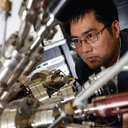Fungistatic activity of heat-treated flaxseed determined by response surface methodology.
Palavras-chave
Resumo
The objective of this study was to evaluate the effect of heat treatment on the fungistatic activity of flaxseed (Linum usitatissimum) in potato dextrose agar (PDA) medium and a fresh noodle system. The radial growth of Penicilliumn chrysogenum, Aspergillus flavus, and a Penicillium sp. isolated from moldy noodles, as well as the mold count of fresh noodle enriched with heat treated flaxseed, were used to assess antifungal activity. A central composite design in the response surface methodology was used to predict the effect of heating temperature and time on antifungal activity of flaxseed flour (FF). Statistical analysis determined that the linear terms of both variables (that is, heating temperature and time) and the quadratic terms of the heating temperature had significant (P<0.05) effects on the radial growth of all 3 test fungi and the mold count log-cycle reduction of fresh noodle. The interactions between the temperature and time were significant for all dependent variables (P<0.05). Significant reductions in antifungal activities were found when FF was subjected to high temperatures, regardless of heating time. In contrast, prolonging the heating time did not substantially affect the antifungal activities of FF at low temperature. However, 60% of the antifungal activity was retained after FF was heated at 100 degrees C for 15 min, which suggests a potential use of FF as an antifungal additive in food products subjected to low to mild heat treatments.


